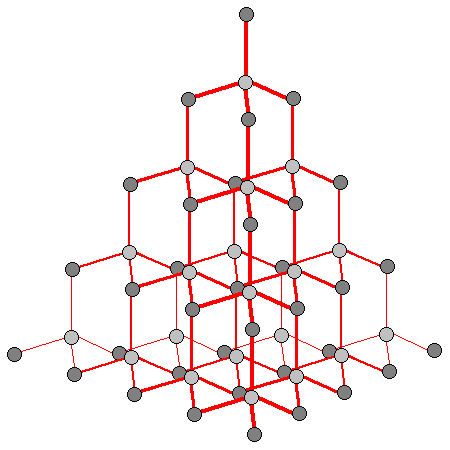Press-fit construction set
For my construction set, I made a diamond lattice from acrylic. A diamond lattice is made from many stacked tetrahedra. A tetrahedron is composed of four triangles, making it very strong. This structure is repeated compactly throughout the carbon atoms and bonds of a diamond, resulting in the crystal's phenomenal strength.

The first challenge was to make a tetrahera out of 2D parts. Relative to the next challenge, this was pretty simple: I modeled a tetrahedron in Solidworks and made two parts that locked well together to form the four points of the tetrahedron.
Connectors:
I then had to devise connections between the tips of the tetrahedron to connect to the others. In effect, the center of each tetrahedron part represents a carbon atom, and a connector between two tips represents a covalent bond. Unfortunately, the connections could not simply be perpendicular, like the connection between the two parts of the tetrahedron. As a result, I needed to have something that could rotate the orientation of how two adjacent tetrahedra aligned. My solution was a circular piece, placed perpendicular to the other two planes, with six slots to allow three possible orientations. This flexibility allowed me the convenience of only fabricating two types of part to construct my lattice. Without it, I would have had to think much more about the problems caused by each 'bond' having a specific orientation.
Challenges:
I used 1/8" clear acrylic plastic sheet for the majority of my structure. I also experimented with 1/4" acrylic for the circular connectors because their thickness gave a better 'aspect ratio' (Saint Venant's principle). However, I ran into problems with the drafted cut from the laser. I solved this by doubling up the circular connectors (Symmetry and Reciprocity principles). This, however, necessitated the addition of another type of part, a simple pin.
With regards to actually designing for the laser cutter, I found that it was always easier to add offsets to account for kerf in the CorelDraw program, instead of trying to incorporate them into my accurate model in Solidworks. Also, where pins from the tetrahedron parts were enclosed on all four sides by the slots, it was necessary to leave a bit of space in one direction, so that the press-fit was only in one direction and Poisson's ratio was satisfied.